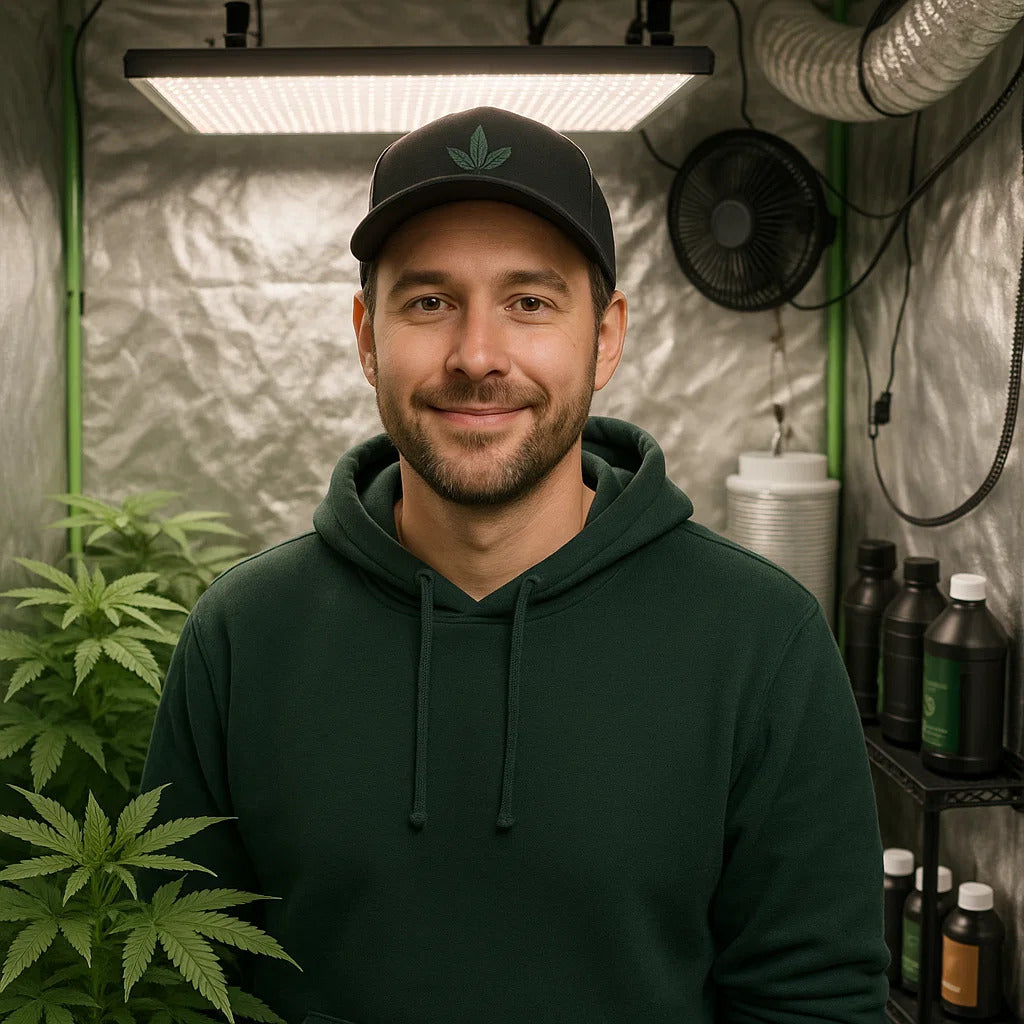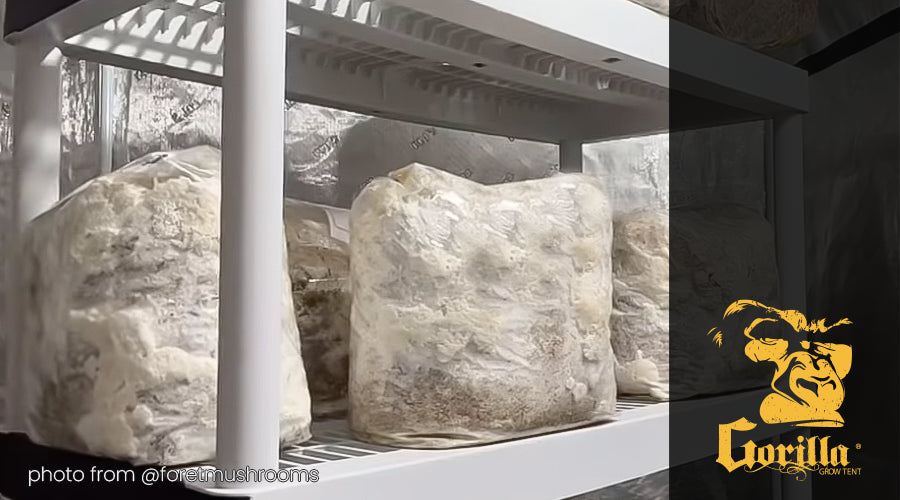
How to Grow Magic Mushrooms
Unlocking the Secrets: How to Grow Magic Mushrooms?
Magic mushrooms (psilocybin mushrooms) typically involves cultivating specific species of mushrooms that contain psychoactive compounds like psilocybin and psilocin. It's important to note that the cultivation and use of magic mushrooms may be illegal in many jurisdictions, and it's crucial to research and understand the laws in your area before attempting to grow them.
If you are in a region where it is legal to cultivate magic mushrooms for personal use and you are interested in learning more about the process, here is a general overview of how to grow magic mushrooms:

Your Comprehensive Guide to Magic Mushroom Cultivation
Research and Education: Before attempting to grow magic mushrooms, thoroughly research the process, materials, and equipment needed. Numerous online resources, books, and forums are dedicated to the subject. Make sure to consult reliable and reputable sources.
Strain Selection: Choose a strain of magic mushrooms that is suitable for cultivation and meets your desired effects. Popular strains include Psilocybe cubensis and Psilocybe cyanescens, among others.
Substrate Preparation: Magic mushrooms require a growth medium, known as a substrate, to grow. Common substrates include a mixture of vermiculite, brown rice flour, and water. The substrate provides the necessary nutrients for the mushrooms to thrive.
Inoculation: Sterilize your substrate mixture to eliminate potential contaminants, then inoculate it with mushroom spores or mycelium. Spores are microscopic reproductive cells of the mushroom, while mycelium is the vegetative part of the fungus.
Incubation: Place the inoculated substrate in a clean, dark, and warm environment to allow the mycelium to colonize the substrate. This phase may take several weeks, and it's important to maintain a sterile environment to prevent contamination.
Fruiting Conditions: Once the substrate is fully colonized with mycelium, induce fruiting conditions. This typically involves exposing the substrate to fresh air, humidity, and light. Maintain appropriate temperature and humidity levels to encourage mushroom growth.
Harvesting: As the mushrooms grow, they will develop caps and stems. Harvest the mushrooms when the caps have fully opened but have not yet released their spores. Use clean and sanitized tools to avoid contamination.
Drying and Storage: After harvesting, dry the mushrooms thoroughly to prevent mold growth. Once dried, store them in an airtight container in a cool, dark place.
Choosing a Growing Method for Magic Mushrooms
There are different methods for growing magic mushrooms, such as the PF Tek (Psilocybe Fanaticus Technique), monotub, and agar techniques. Research and choose the method that suits your level of experience and available resources.
Substrate Formulation: Substrates can vary based on the specific method you choose. Some methods use a combination of vermiculite and brown rice flour, while others incorporate materials like coir (coconut fiber) or straw. Each substrate formulation provides different nutritional content for the mycelium.
Agar Cultures: Agar is a gelatinous medium used to isolate and propagate specific strains of mushroom mycelium. Agar cultures can help ensure the purity and vitality of your mycelium before transferring it to a substrate.
Spore Germination: If you're starting with spore syringes, you'll need to germinate the spores on an agar medium. Agar provides a controlled environment for spores to develop into mycelium. This step helps ensure you're working with viable and healthy spores before inoculating your substrate.
Grain-to-Grain Transfer: Instead of using spores, you can transfer colonized mycelium from one substrate to another. This process, known as grain-to-grain transfer, helps maintain the genetic traits and vitality of a specific strain.
Elevating Your Magic Mushroom Garden with a Grow Tent
Setting up a grow tent for magic mushrooms can provide a controlled and optimized environment for their cultivation. While grow tents are more commonly associated with indoor cultivation, they can also be adapted for growing other types of plants and fungi, including magic mushrooms. Here's a basic guide to setting up a grow tent for cultivating magic mushrooms:
- Choose the Right Size: Select a grow tent size that suits the scale of your cultivation. Magic mushroom grow kit cultivation doesn't typically require a large space, so a smaller tent (e.g., 2'x2' or 3'x3') should suffice for most home cultivators.
- Tent Features: Look for a tent with features such as sturdy construction, strong zippers, lightproof fabric, and multiple ventilation ports. These features will help you maintain a controlled environment.
- Ventilation and Air Exchange: Proper air exchange is crucial for successful mushroom cultivation. You'll need to set up exhaust fans, intake fans, or vents to ensure a continuous flow of fresh air. This helps prevent the buildup of carbon dioxide and humidity, which can lead to contamination.
- Lighting: While magic mushrooms don't require intense light like some other plants, they do need a light source to initiate the fruiting process. You can use low-intensity fluorescent or LED lights on a 12/12 light-dark cycle to simulate natural daylight.
- Humidity Control: Magic mushrooms require high humidity during the fruiting stage. You can achieve this by using a humidifier, mister, or by placing a container of water inside the tent. Monitor and adjust humidity levels regularly.
- Temperature Regulation: Maintain the appropriate temperature range for mushroom growth (usually around 70-75°F or 21-24°C). Depending on your environmental conditions, you might need to use a small space heater or cooling fan.
- Fruiting Conditions: Once the mycelium has colonized the substrate, induce fruiting conditions by increasing fresh air exchange and maintaining high humidity. This encourages the development of mushroom fruiting bodies.
- Substrate and Container: Prepare your magic mushroom substrate (e.g., vermiculite and brown rice flour mixture) and place it in suitable containers. These containers can be placed inside the grow tent.
A Closer Look at Responsible Magic Mushrooms
Magic mushrooms, also known as psychedelic mushrooms or shrooms, are a type of fungi that contain psychoactive compounds, most notably psilocybin, and psilocin. These compounds have the ability to induce altered states of consciousness, hallucinations, and other perceptual changes when ingested.
Psilocybin is converted into psilocin in the body, which then affects the brain's serotonin receptors, leading to mood, perception, and cognition changes. The effects of magic mushrooms can vary widely depending on factors such as the specific species of mushroom, dosage, individual sensitivity, and the setting in which they are consumed.
Common effects of consuming magic mushrooms may include:
Altered perception: Users often report changes in sensory perception, including vivid colors, intensified patterns, and distortions of shapes and sizes.
Hallucinations: Visual and auditory hallucinations are shared, where individuals may see and hear things that are not present.
Euphoria and emotional changes: Many users experience feelings of happiness, euphoria, and a sense of connection to the universe or other people.
Spiritual experiences: Some people report having profound spiritual or mystical experiences while under the influence of magic mushrooms.
Changes in time perception: Users might feel that time is passing more slowly or that they have a distorted sense of time.
Introspection and insight: Magic mushrooms can lead to deep self-reflection and insights into one's thoughts, emotions, and life experiences.
It's important to note that using magic mushrooms is illegal in many countries and can carry legal and health risks. Sometimes, consuming magic mushrooms can lead to negative experiences, including anxiety, paranoia, or a "bad trip." The effects of magic mushrooms can also vary significantly from person to person, and there is potential for psychological and emotional harm, especially in those with a history of mental health issues.
If you're considering using magic mushrooms or any other psychoactive substances, it's important to be well-informed about your area's risks, potential benefits, and legal status. It's also good to consult a healthcare professional with any concerns or questions.
Getting Started with Magic Mushroom Cultivation: Tips and Techniques
Sterilization and Sanitization: Maintaining a sterile and clean environment is crucial throughout the cultivation process to prevent contamination by unwanted microorganisms. Use proper sterilization techniques for all equipment, substrates, and materials to ensure the growth of healthy mycelium.
Growing Containers: You can use various types of containers for growing magic mushrooms, such as plastic containers, jars, or bags. Make sure to create holes or provide a way for fresh air exchange and proper humidity levels.
Humidity and Air Exchange: Magic mushrooms require high humidity levels and proper air exchange for successful fruiting. You may need to mist the growing environment periodically to maintain humidity and ensure that fresh air reaches the developing mushrooms.
Light Exposure: While magic mushrooms do not require direct sunlight, they do need a light source to trigger the development of fruiting bodies. Indirect light from fluorescent or LED lights can be used to simulate natural daylight.
Flushing and Harvesting: Once the mushrooms start to develop, they will go through multiple growth phases called flushes. After each flush, the mushrooms can be harvested by gently twisting or cutting them at the base. Allow the mycelium to recover before inducing the next flush.
Fruiting Chamber: A controlled environment is crucial for successful fruiting. Consider using a designated fruiting chamber or setup, such as a monotub, where you can control humidity, temperature, and fresh air exchange more effectively.
Temperature Control: Magic mushrooms have specific temperature requirements for different stages of growth. Maintaining the right temperature range (usually between 70-75°F or 21-24°C) is essential for optimal mycelium growth and fruiting.
Hygiene and Sterilization: Practicing strict hygiene and sterilization techniques cannot be emphasized enough. Contaminants can quickly take over your growing environment and ruin your efforts. Use a pressure cooker to sterilize substrates and equipment effectively.
Patience and Observation: Mushroom cultivation takes time. Be patient and observe your mushrooms closely during every stage of growth. Monitoring their development and making adjustments as needed will increase your chances of success.
Post-Harvest Handling: After harvesting, properly store and preserve your harvested mushrooms. Some cultivators choose to make mushroom tea, dry them, or prepare other forms for consumption.
Environmental Considerations: Magic mushrooms are sensitive to environmental changes. Avoid exposure to drafts, extreme temperatures, and direct sunlight during the growing process.
Learning from Experience: Your first attempts at growing magic mushrooms may not be perfect, and that's okay. Learning from your mistakes and adjusting your techniques over time is a normal part of the cultivation process.
Personal Well-Being: Magic mushrooms can have profound effects on your mental and emotional state. Approach their cultivation and use with respect and responsibility. If you decide to consume them, do so in a safe and supportive environment, and consider the potential psychological and health implications.
Dunking and Rolling: Dunking involves submerging your substrate in water to rehydrate it between flushes. After dunking, you can roll the damp substrate in a layer of vermiculite or another casing material to help maintain humidity and provide a microclimate for mushroom formation.
Contaminant Identification and Management: Contaminants can quickly ruin your cultivation efforts. Learn to identify common contaminants such as molds, bacteria, and other fungi. If contamination occurs, it's best to dispose of the contaminated materials to prevent further spread.
Genetic Isolation: If you're interested in preserving specific genetic traits or developing your own unique strains, consider isolating and working with individual mycelium cultures. This can involve isolating a single rhizomorphic mycelium strand for further propagation.
Record Keeping: Keeping detailed records of your cultivation process can help you track your progress, learn from your successes and failures, and make informed decisions for future grows.
Ethical Harvesting: When harvesting, use clean tools and handle the mushrooms gently to avoid damaging the mycelium. Leaving a small portion of the stem attached to the substrate can help stimulate subsequent flushes.
Remember, the cultivation of magic mushrooms carries legal and ethical considerations. It's essential to emphasize that growing magic mushrooms may be illegal in your jurisdiction, and my response is not an endorsement or encouragement of illegal activities. Always prioritize legality, safety, and responsible decision-making. If you have questions about the legal status of magic mushrooms in your area, consult legal resources or seek advice from legal professionals.
If you're new to mushroom cultivation, consider starting with legal and edible mushroom species to gain experience before attempting to grow magic mushrooms.
Unveiling the Mystery: Do Mushrooms Need Light to Grow?
Mushrooms, those enigmatic and fascinating organisms, have captivated the human imagination for centuries. With their diverse shapes, sizes, and colors, they seem to emerge from the depths of nature's shadowy corners. However, a common misconception persists: do mushrooms need light to grow?
This blog article will delve into the intriguing world of mushroom cultivation to uncover the truth behind this puzzling question.
The Role of Light in Mushroom Growth
Unlike plants that rely on photosynthesis to produce food, mushrooms are fungi with a fundamentally different way of obtaining nutrients. Instead of using light to generate energy, mushrooms feed on organic matter and decompose it through a process known as saprophytic nutrition. Therefore, light does not play a direct role in their energy production.
While it's true that mushrooms do not require light for energy synthesis, light does influence some aspects of their growth and development. Let's explore these factors in more detail.
The Light-Dependent Phases
While mushrooms differ significantly from plants in their nutritional requirements, light does play a role in certain stages of their growth. Let's delve into the fascinating interplay between mushrooms and light:
Mycelial Growth: The initial phase of mushroom development, mycelial colonization, occurs in the dark. The mushroom mycelium, a network of fine threads, extends through the substrate in search of nutrients. Light is not a direct factor during this phase, as mushrooms do not use it for energy production.
Primordia Formation: As the mycelium matures, it prepares to transition to the next stage: primordia formation. In some mushroom species, exposure to light becomes crucial at this point. Light acts as a signal, prompting the mycelium to initiate the development of primordia, the early stages of fruiting bodies.
Fruiting Body Development: Once primordia are formed, they develop into mature fruiting bodies or mushrooms. While light isn't directly required for energy synthesis, but it can influence these emerging structures' growth patterns and orientations.
Light Influence on Growth Patterns
While mushrooms do not photosynthesize, exposure to light can affect the growth patterns of fruiting bodies. For instance, mushrooms may exhibit phototropic responses, growing toward a light source. This phenomenon is more pronounced in some species compared to others.
Natural Habitat Considerations
In the wild, mushroom habitats vary widely, and light availability can differ significantly. Some mushrooms thrive in dimly lit environments, such as the forest floor, while others may be found in more open areas where light is more abundant.
Mushroom Species and Light Preferences
The relationship between mushrooms and light varies among species, reflecting their diverse adaptations to different environments. Consider the following:
Light-Loving Mushrooms: Some mushroom species thrive in well-lit environments, often emerging from open spaces where sunlight is abundant. These mushrooms typically require light to initiate fruiting body development. Examples include the Button Mushroom (Agaricus bisporus) and the Oyster Mushroom (Pleurotus ostreatus).
Shade-Tolerant Mushrooms: Conversely, many mushrooms prefer shaded or dimly lit habitats. These species often thrive on the forest floor or in other areas with reduced light exposure. They might not require light to trigger fruiting, relying instead on other environmental cues. The Shiitake Mushroom (Lentinula edodes) and the Lion's Mane Mushroom (Hericium erinaceus) fall into this category.
Cultivation Practices: Light and Mushrooms
When cultivating mushrooms, the role of light becomes a matter of careful consideration and balance. Different mushroom species have varying light preferences, and successful cultivation often requires mimicking the natural conditions that trigger fruiting. Here are a few key points to keep in mind:
Research Your Species:
Investigate the light requirements of the specific mushroom species you intend to cultivate. Knowing whether they need light to initiate primordia formation will guide your cultivation approach.
Light Duration and Intensity:
For species that require light to trigger fruiting, a period of light exposure is typically needed. However, this doesn't necessarily mean intense sunlight. In many cases, diffused or indirect light is sufficient to initiate primordia formation.
Duration of Light Exposure:
The duration of light exposure can vary depending on the species. Some mushrooms may require a brief exposure to light, while others might need longer periods. I think it's essential to research the specific requirements of the mushroom you are cultivating.
Light Sources:
Artificial light sources, such as fluorescent, LED, or incandescent lights, can be used to provide the necessary light exposure for mushroom cultivation. These sources allow growers to control the light cycle more precisely, ensuring optimal conditions for primordia formation.
In the intricate world of mushroom growth, light plays a nuanced role that goes beyond energy production. While mushrooms do not require light for sustenance, it can influence critical stages of their life cycle, including primordia formation and growth patterns. Successful mushroom cultivation involves understanding the specific light requirements of the chosen species and providing the appropriate conditions to trigger fruiting.
As we continue to unlock the mysteries of fungi, our appreciation for these remarkable organisms deepens. Whether they emerge from the dark forest floor or thrive in the subtle glow of artificial light, mushrooms remind us of the intricate relationships between life forms and the environments they inhabit.
So, the next time you encounter a cluster of mushrooms, take a moment to appreciate the subtle dance between light and fungi. Whether they're embracing the sun's rays in an open meadow or flourishing in the dappled shade of a forest, mushrooms continue to illuminate our understanding of life's incredible diversity.

Lena Myles
I'm a mushroom enthusiast and home cook based in Oregon. I'm passionate about foraging and creating fungi-focused recipes, especially delicious, plant-based dishes using gourmet mushrooms like trumpet, shiitake, and oyster. When I’m not in the kitchen, you’ll usually find me wandering the woods in search of new wild flavors.


